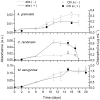Host-specificity and dynamics in bacterial communities associated with Bloom-forming freshwater phytoplankton
- PMID: 24465807
- PMCID: PMC3896425
- DOI: 10.1371/journal.pone.0085950
Host-specificity and dynamics in bacterial communities associated with Bloom-forming freshwater phytoplankton
Abstract
Many freshwater phytoplankton species have the potential to form transient nuisance blooms that affect water quality and other aquatic biota. Heterotrophic bacteria can influence such blooms via nutrient regeneration but also via antagonism and other biotic interactions. We studied the composition of bacterial communities associated with three bloom-forming freshwater phytoplankton species, the diatom Aulacoseira granulata and the cyanobacteria Microcystis aeruginosa and Cylindrospermopsis raciborskii. Experimental cultures incubated with and without lake bacteria were sampled in three different growth phases and bacterial community composition was assessed by 454-Pyrosequencing of 16S rRNA gene amplicons. Betaproteobacteria were dominant in all cultures inoculated with lake bacteria, but decreased during the experiment. In contrast, Alphaproteobacteria, which made up the second most abundant class of bacteria, increased overall during the course of the experiment. Other bacterial classes responded in contrasting ways to the experimental incubations causing significantly different bacterial communities to develop in response to host phytoplankton species, growth phase and between attached and free-living fractions. Differences in bacterial community composition between cyanobacteria and diatom cultures were greater than between the two cyanobacteria. Despite the significance, major differences between phytoplankton cultures were in the proportion of the OTUs rather than in the absence or presence of specific taxa. Different phytoplankton species favoring different bacterial communities may have important consequences for the fate of organic matter in systems where these bloom forming species occur. The dynamics and development of transient blooms may also be affected as bacterial communities seem to influence phytoplankton species growth in contrasting ways.
Conflict of interest statement
Figures






Similar articles
-
Characterization of bacterial community associated with phytoplankton bloom in a eutrophic lake in South Norway using 16S rRNA gene amplicon sequence analysis.PLoS One. 2017 Mar 10;12(3):e0173408. doi: 10.1371/journal.pone.0173408. eCollection 2017. PLoS One. 2017. PMID: 28282404 Free PMC article.
-
Harmful freshwater algal blooms, with an emphasis on cyanobacteria.ScientificWorldJournal. 2001 Apr 4;1:76-113. doi: 10.1100/tsw.2001.16. ScientificWorldJournal. 2001. PMID: 12805693 Free PMC article. Review.
-
Structural Diversity of Bacterial Communities Associated with Bloom-Forming Freshwater Cyanobacteria Differs According to the Cyanobacterial Genus.PLoS One. 2015 Nov 18;10(11):e0140614. doi: 10.1371/journal.pone.0140614. eCollection 2015. PLoS One. 2015. PMID: 26579722 Free PMC article.
-
The phyto-bacterioplankton couple in a shallow freshwater ecosystem: Who leads the dance?Harmful Algae. 2023 Jul;126:102436. doi: 10.1016/j.hal.2023.102436. Epub 2023 Apr 27. Harmful Algae. 2023. PMID: 37290884
-
Blooming in the Anthropocene: Perspectives on the development of freshwater blooms, changing phytoplankton communities, and mitigation strategies.Harmful Algae. 2025 Aug;147:102883. doi: 10.1016/j.hal.2025.102883. Epub 2025 May 5. Harmful Algae. 2025. PMID: 40449985 Review.
Cited by
-
Diverse interactions between bacteria and microalgae: A review for enhancing harmful algal bloom mitigation and biomass processing efficiency.Heliyon. 2024 Aug 24;10(17):e36503. doi: 10.1016/j.heliyon.2024.e36503. eCollection 2024 Sep 15. Heliyon. 2024. PMID: 39286093 Free PMC article. Review.
-
Species-specific effects and the ecological role of programmed cell death in the microalgae Ankistrodesmus (Sphaeropleales, Selenastraceae).Biol Lett. 2022 Oct;18(10):20220259. doi: 10.1098/rsbl.2022.0259. Epub 2022 Oct 19. Biol Lett. 2022. PMID: 36259168 Free PMC article.
-
Spatio-temporal connectivity of the aquatic microbiome associated with cyanobacterial blooms along a Great Lake riverine-lacustrine continuum.Front Microbiol. 2023 Feb 9;14:1073753. doi: 10.3389/fmicb.2023.1073753. eCollection 2023. Front Microbiol. 2023. PMID: 36846788 Free PMC article.
-
Metagenomics Analysis to Investigate the Microbial Communities and Their Functional Profile During Cyanobacterial Blooms in Lake Varese.Microb Ecol. 2022 May;83(4):850-868. doi: 10.1007/s00248-021-01914-5. Epub 2021 Nov 12. Microb Ecol. 2022. PMID: 34766210 Free PMC article.
-
The Phytoplankton Taxon-Dependent Oil Response and Its Microbiome: Correlation but Not Causation.Front Microbiol. 2019 Mar 11;10:385. doi: 10.3389/fmicb.2019.00385. eCollection 2019. Front Microbiol. 2019. PMID: 30915045 Free PMC article.
References
-
- Sinha R, Pearson LA, Davis TW, Burford MA, Orr PT, et al. (2012) Increased incidence of C. raciborskii in temperate zones-is climate change responsible? Water Research 46: 1408–1419. - PubMed
-
- Vieira AAH, Ortolano PIC, Giroldo D, Oliveira MJD, Bittar TB, et al. (2008) Role of hydrophobic extracellular polysaccharide of Aulacoseira granulata (Bacillariophyceae) on aggregate formation in a turbulent and hypereutrophic reservoir. Limnology and Oceanography 53: 1887–1899.
-
- Huisman J, Jonker RR, Zonneveld C, Weissing FJ (1999) Competition for light between phytoplankton species: experimental tests of mechanistic theory. Ecology 80: 211–222.
-
- Paerl HW (1996) Microscale physiological and ecological studies of aquatic Cyanobacteria: macroscale implications. Microscopy Research and Technique 33: 47–72. - PubMed
Publication types
MeSH terms
LinkOut - more resources
Full Text Sources
Other Literature Sources

